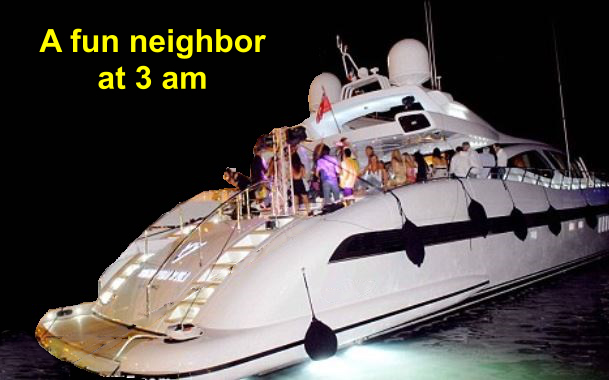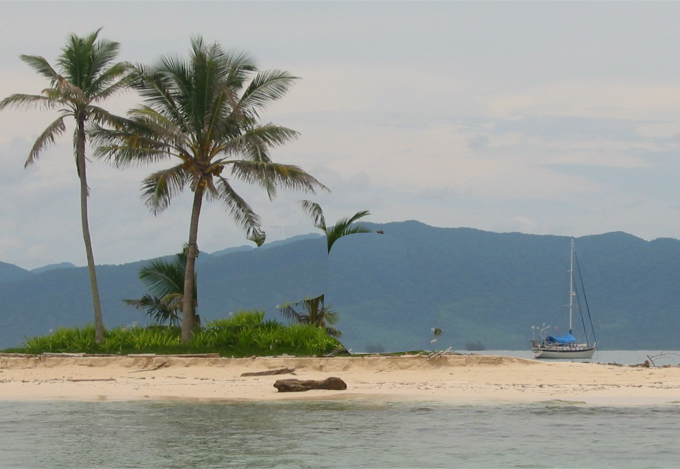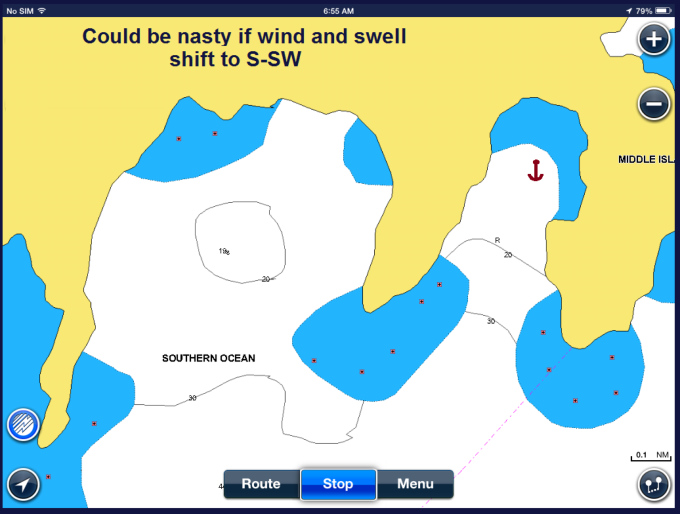The Blue View - Anchorage Etiquette
/As we approach a new anchorage, drop the hook and set up housekeeping, we try to do our best to be a good neighbor. Beyond the basic safety issues – where to drop the hook, how to set the anchor, how much scope to use, etc., there are a number of things we avoid doing that will annoy everyone else in the anchorage. Some of these are just common sense and some we learned by watching other boats.
Hopefully, I won't sound too much like a grumpy old curmudgeon as I list the “Nine of Cups Rules of Proper Anchoring Etiquette” for your consideration:
- First boat in sets the rules. The first boat to anchor is the one that sets the rules and has the “right of way”. If you arrive in an anchorage and the other boat or boats are using two bow anchors, you should follow suit. If a boat anchored nearby thinks you are too close, you are obligated to move. If you are the first boat in, think about this as you anchor. Using a scope of 10:1 is probably overkill, and will certainly be a problem if the anchorage fills up. While technically you have the right to do this, you will most certainly have issues trying to get the next 10 boats to anchor far enough away to provide that much swinging room.
- Anchoring near other boats. I don't know how many times we have been anchored in an idyllic spot all by ourselves, only to watch a boat approach and drop their anchor a boat length or less away, despite the fact there was miles of open beach on either side of us. Maybe they think we hunted around for hours looking for just the right spot and, therefore, this is the only place that is safe. If the anchorage is small or crowded, you may not have a choice, but if there is space, always try to anchor a reasonable distance away from the boat or boats already there.
- Generators. A lot of larger sailboats and most power boats have generators. If you have a generator and will be running it, try to anchor near like boats who will also be running theirs. Avoid anchoring directly upwind of another boat. If possible, try to limit the hours you will be running it to mid-morning or afternoon when the noise will be least annoying to others in the anchorage. If you will be running your generator all night to power your air conditioning, try to anchor as far away as possible from those of us who prefer a quiet, peaceful anchorage.
- Power tools. Remember the old definition that cruising is repairing your boat in exotic places? Most of us will find ourselves needing to run a power tool from time to time while anchored. As with a generator, try to be considerate when running it. If possible, anchor well away from the other boats, and limit the usage to the less annoying times. If you will be generating dust or debris, don't anchor upwind of another boat. Don't begin work at sunrise.
- Partying. Most of us enjoy getting together with other cruisers. Having potluck dinners and enjoying sundowners with new and old friends are part and parcel of the cruising life. Unless you are inviting all the neighboring boats, however, be considerate, both in the amount of noise and how late you intend to “party on”. Sound carries very well over the water, and not everyone shares your taste in music or finds a joke from a loud, inebriated sailor enjoyable (though that's hard to believe).
- Dumping. Rules vary around the world regarding the use of holding tanks and pumping wastewater overboard. Make sure you know and follow the local ordinances. Beyond the laws, however, common courtesy suggests that if people are swimming in the anchorage, you should avoid dumping raw waste into the water. Biodegradable garbage should be held until going to shore or heading offshore. Those banana skins, egg shells and potato peels will more than likely wash up on the beach.
- Wakes. As you meander through the anchorage, whether in the mothership or the tender, keep your speed low enough to avoid making a wake. You won't make any friends if you knock over their sundowners.
- Toys. Many boats carry water toys aboard – kayaks, jet skis, water skis, sailing dinghies, sail boards. The wind and human-powered toys are usually quiet and unobtrusive. Others, like jet skis and the fast tenders pulling water skiers, are quite annoying, both because of the wake generated and the noise pollution. Don't think for a second that anyone else in the anchorage will enjoy watching at close hand your water skiing skills. Slowly motor your toy far away from the other boats, then have a ball.
- Voices. Voices carry remarkably well over the water. Be assured that everyone within a half mile will be privy to the argument you are having with your spouse or the loud cell phone conversation you are having with your stock broker. Keep your voice down. Use the hand signals you learned in an earlier blog when dropping and raising the anchor. Sometimes, listening to loud conversations on other boats is entertaining and amusing, but more often it is just annoying.
- Anchor lights. When anchored at night, you should always have an anchor light on. Most sailboats use a white light at the top of the mast. While this meets the legal requirements for an anchor light, we have found that this often isn't enough. Usually the crew of a boat making its way through an anchorage at night is peering straight ahead looking for obstacles and not 60 feet (18m) in the air where the anchor light is located. Nine of Cups, as well as the boats of several of our friends, have been run into at night, despite the fact that all were using masthead anchor lights. We now augment our anchor light with another light mounted above the cockpit. Since the lights are LEDs, there is very little extra power required, and so far we haven't been rammed since we began using it. That said, don't overdo it. If you like lighting your boat up like a cruise ship, either anchor well away from the rest of the fleet or tone it down at bedtime.
- Spotlights. Spotlights and high intensity LED flashlights are great for finding your way through a crowded anchorage at night, but be considerate. Use them to pick out obstacles in the water – mooring balls, anchor rodes, markers, etc. Don't use them to illuminate the other boats as you approach. If you are worried about a vessel approaching your anchored boat at night, don't shine the light at the oncoming boat. Shining a light in the eyes of the approaching crew will most likely blind them for a few minutes, making matters worse. Instead, turn your spreader lights on and shine your spotlight on your own hull which will make you more visible.
- Dogs. A lot of cruisers we've met have dogs. Most are well-behaved, friendly pets that provide companionship to the owners and security to the boat. Some, however, bark – a lot. Some bark whenever the crew goes ashore without them. Some bark the entire night through or whenever there is anyone in sight on the boats anchored nearby. If you have one of these dogs, do the rest of us a favor. Either get one of those collars that teach it not to bark or anchor somewhere far from the rest of us – maybe next to the guy who is running his generator, air conditioning and 20,000,000 candlepower deck lights all night.
So what do we do if we are following the “Nine of Cups Rules of Proper Anchoring Etiquette” and trying to be a good neighbor, but a boat anchored next to us isn't? Many times people just don't realize that something they are doing is unpleasant for the rest of us, like starting their generator at 6 AM or just as everyone is enjoying the sunset, and a tactful suggestion is all it takes. Sometimes, the other people could not care less about annoying everyone else in the anchorage, like the weekenders who like to have a party aboard that lasts all night, complete with blaring music and high speed tenders going to and from shore, with 15-20 of their closest, loudest friends. While we have often hoped they would drag anchor out to sea or have considered cutting their anchor rode, in the end, all we can do is either grin and bear it or move. We've done both.







